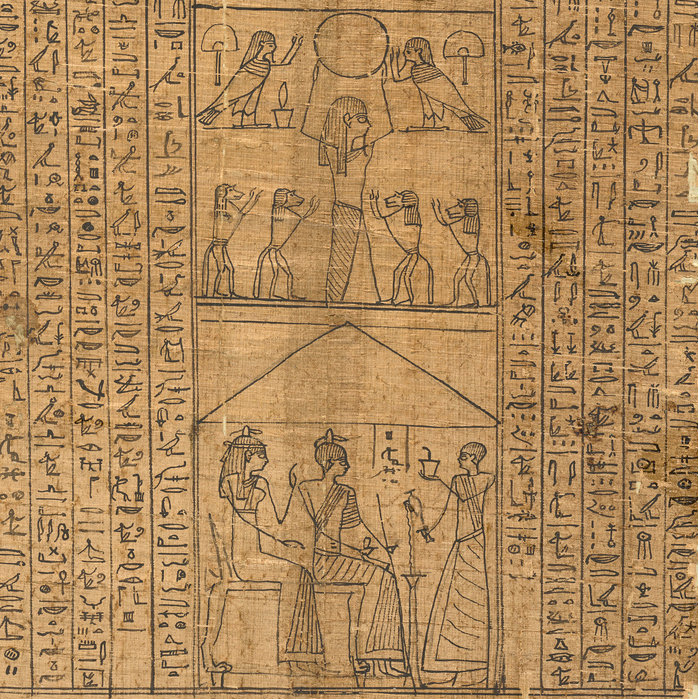In the Book of the Dead—a manuscript custom-created for ancient Egyptians who could afford one—the crucial moment comes after the owner dies, when the gods weigh his or her heart against a feather. A pure heart will balance out. Awaiting the result is the hybrid monster Ammit, a lion in front, a hippo in back, her toothy crocodile jaws wide open. If the heart fails the test, Ammit will gobble it up, and instead of gaining eternal life, the owner’s spirit will vanish.
In the millennia-old papyrus that belonged to an Egyptian named Pasherashakhet, the feather test comes with a large ink drawing showing minor and major gods, the weighing scales, the heart, the monster, and Pasherashakhet himself. It’s one of the highlights of “The Egyptian Book of the Dead,” an exhibition that opens on November 1 at the Getty Villa, the antiquities-oriented campus of the museum, located in the low hills of California’s Pacific Palisades. In the Getty collection for four decades, the papyrus scrolls, inscribed mummy wrappings, and associated materials have never before been shown to the public. Until recently, the Getty itself had not delved deeply into this part of its collection, says the exhibition’s curator, Sara E. Cole. The Getty’s Roman, Greek, and Etruscan works are far better known.

Visitors’ first surprise may be that the Book of the Dead is not a book. It’s a collection of nearly 200 recitations and instructions, known as “spells,” written on various objects and meant to accompany a dead person to the afterlife. They amount to a kind of guidebook and script for the departed, to ensure their union with the gods and a “cycle of continuous renewal and rebirth,” as Cole puts it. Though they’re up to three and a half millennia old, the papyri are surprisingly legible—or are, at least, for anyone who can read the abridged version of hieroglyphs used in many of them.

That left out most ancient Egyptians, of course, who were illiterate. A large industry of scribes existed to create custom-written copies of the Book of the Dead, but only people of means, largely involved in the court and religious life, would be able to buy one before death or get one from relatives postmortem. Pasherashakhet, who lived around 300 B.C., worked as a temple doorkeeper, though his mother’s titles indicate her high standing in society.
Other “book” owners in the Getty’s collection were women who had religious posts as ritual singers. A fourth owner, male, held religious posts as well as titles such as Royal Chancellor of Lower Egypt, which explains how he could afford to be buried with 336 ceramic statuettes, each seven to eight inches tall, known as “ushabtis.” The one on view holds a hoe, a pick, and a seed bag—and is inscribed with a spell that, when spoken aloud, would animate the figurine to do farm chores to nourish the dead master in his afterlife.

To Cole, what’s most poignant in the Book of the Dead is how it reflects the undying anxieties of the living. She believes the manuscripts were linked to oral religious practices that answered the needs of daily life while reassuring those who—then and now—ask what will happen to them after they die. As for Pasherashakhet, the illustrators of his papyrus made sure that things worked out. Their portrayals capture a moment Egyptians would have known well, when Thoth, the god of writing, announces the results to the netherworld god Osiris: “His heart is safe upon the scale without fault found.” Osiris replies, “Welcome, welcome in peace to the beautiful West.” And so Pasherashakhet entered eternity.
“The Egyptian Book of the Dead” is on at the Getty Villa, in Los Angeles, beginning November 1
Check out AIR MAIL’s Arts Intel Report, our newly revamped research tool for what to do, see, and watch around the world
Peter Saenger has written and edited for The Wall Street Journal on such topics as art, art books, museums, and travel. His fiction has appeared in The New Yorker


